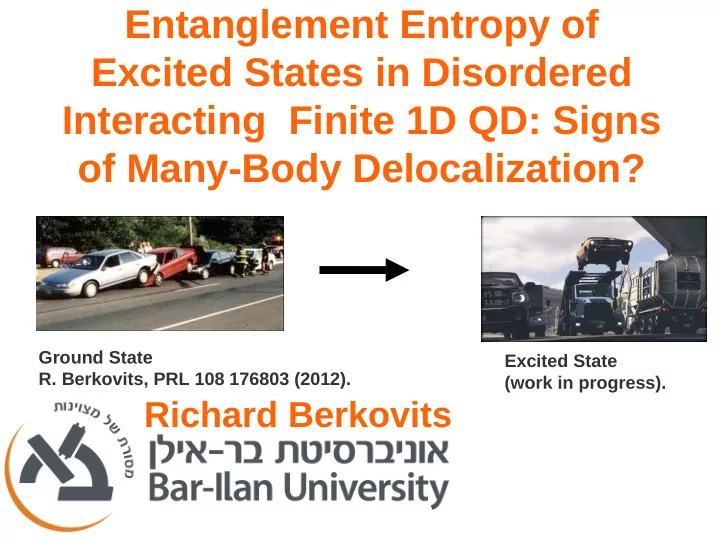

Entanglement Entropy of Excited States in Disordered Interacting Finite 1D QD: Signs of Many-Body Delocalization? Ground State Excited State R. Berkovits, PRL 108 176803 (2012). (work in progress). Richard Berkovits
Delocalization for a disordered interacting system There has been a considerable amount of discussion in the literature on whether electron-electron interactions may enhance the localization length, motivated by the “2DMIT” (2D metal insulator transition) and 2 particle delocalization. For spinless 1D systems it is clear that e-e interactions decrease the ground-state localization length (i.e., lead to stronger localization) The ground state of a 1D disordered system is localized even in the presence of e-e interactions
What about the excited states? Fock space localization Sivan, Imry, Aronov, EPL 28,115 (1994) σ(Τ) α Γ Relevant to infinite systems?
What about the excited states for infinite systems?
Numerical Demonstration: Conductance (especially for finite temperature) is computationally taxing. Level statistics is hard to interpret (requires extrapolation from small systems) R. Berkovits and B. Shklovskii, J. Phys. CM 11, 779 (1999). V. Oganesyan and D. A. Huse, PRB 75, 155111 (2007). Renormalized hoppings (works for infinite temperature) M. Cecile and G. Thomas, PRB 81 134202 (2010). Entanglement Entropy (EE) may be the answer!
EE - Entanglement Entropy System (a) Is in a pure state Divide the system into two regions A and B. Any pure state:
* * Reduced density matrix:
Definition of entanglement entropy i.e. the von Neuman (or Shannon in the context of Information theory) entropy of the reduced density matrix Properties: additivity and convexity
Dependence of EE on dimension, shape and topology of the region A The area law The EE is proportional to the surface area between A and B
Connections between EE and condensed matter physics DMRG – Density Matrix Renormalization Group – an extremely accurate numerical method for the calculation of the ground state of a one-dimensional many-body system QPT – Quantum Phase Transitions – EE exhibits a unique signature in its behavior at a QPT. This enables to identify and study the properties of QPT.
QPT and EE in one-dimensional systems According to the area law resulting in a constant EE for 1D systems Nevertheless for an infinite correlation length there are logarithmic corrections resulting in: while for systems with a finite correlation length (for example gapped systems):
Anderson Localization and EE Metallic regime - extended states, infinite localization length and therefore we expect a logarithmic dependence of the EE for the ground state and a non suppressed EE for the excited states Localized regime – finite localization length (although there is no gap) and therefore we expect a constant EE both for the ground and excited states once the system size exceeds the localization length A good way to identify the localization length for an interacting system
The one-dimensional Hamiltonian L A B L A where the on-site energies are taken from the range [-W/2,W/2] and the LL parameter g:
For the non-interacting case it is numerically known that the localization length depends on the width of the on-site energy distribution: Ro¨mer and Schreiber, PRL 78, 515 (1997). While the influence of interaction was postulated to reduce the ground state localization length by: Apel, J. Phys. C 15, 1973 (1982); Giamarchi and Schulz PRB 37,325 (1988).
Ground state finite size effects (clean system) (Holzhey,Larsen,Wilczek,1994)
Finite size effects (disordered system) R. Berkovits, PRL 108 176803 (2012). For a clean system
Interpolation of ζ Interpolation between the two limits
Interacting systems
No general understanding of the excited states EE is available even for a clean 1D non-interacting system
Two-Particle excited states EE The study of two-particle excited states was very fruitful in understanding interaction induced (de)localization. (D. L. Shepelyansky 1994, Y. Imry 1995) Simple enough to obtain some analytical results for the excited states EE Two-particle state EE
Clean Ring N=1000 Numerical Analytical 3 2 1
Interaction significantly enhances EE above clean limit for high excitations!
How should the many particle delocalization influence the EE? EE of excitations below the critical energy (temperature): Similar behavior to the localized ground state, i.e., saturate at ξ. EE of Excitations above the critical energy: should not saturate. A smoking gun would be no decrease as the system size is enhanced. Location of critical energy should shift with interaction (note that the ground state localization also depends on the interaction strength).
L=700 L=300
S(x)=S'((L/L')x')+Const Very different than for the ground state
Strong disorder ξ<< L L=300 L=700
Weaker disorder ξ< L
Same localization length larger interaction ξ< L As interaction becomes stronger the excited state entanglement increases. Sign of a lower critical excitation energy?
Summary • Entanglement entropy behavior depends on the correlation length of the system. • Thus, EE could be used to identify different phases of a system and identify quantum phase transitions such as the Anderson localization transition. • Furthermore, EE could be used to calculate the correlation (localization) length. • Excited states EE show glimpses of many-electron metal-insulator transition.
Density Matrix Renormalization Group (DMRG)
Numerical Renormalization Group (NRG) 1. Add an additional site 2. Retain only the m states with the lowest energy Works perfectly for impurity problems (Kondo) Fails miserably for extended systems (Luttinger Liquids)
Infinite size DMRG 1. Add an additional site to the system and environment 1. Form the density matrix for the system 3. Retain only the m states with the highest density matrix eigenvalues
Finite size DMRG Iteration improve dramatically the accuracy At each point in the DMRG iteration on has all the ingredients to calculate the EE
Recommend
More recommend